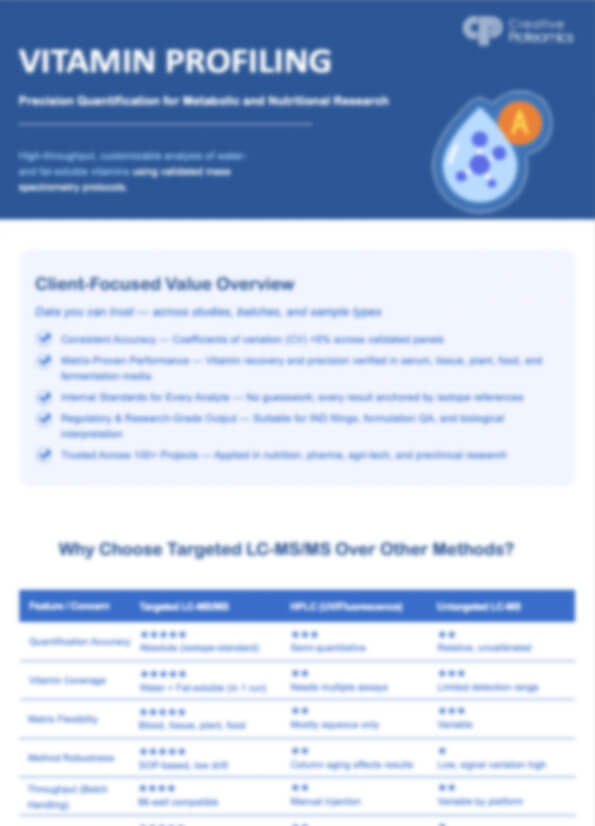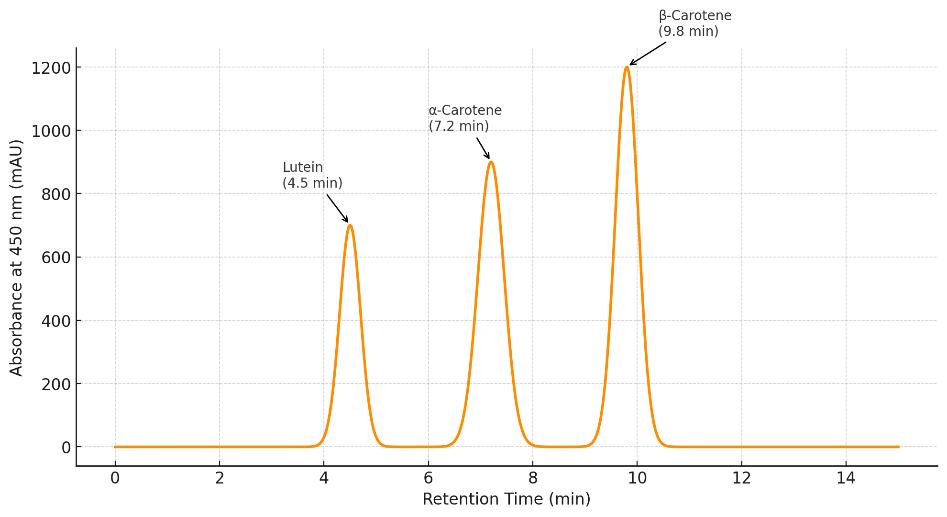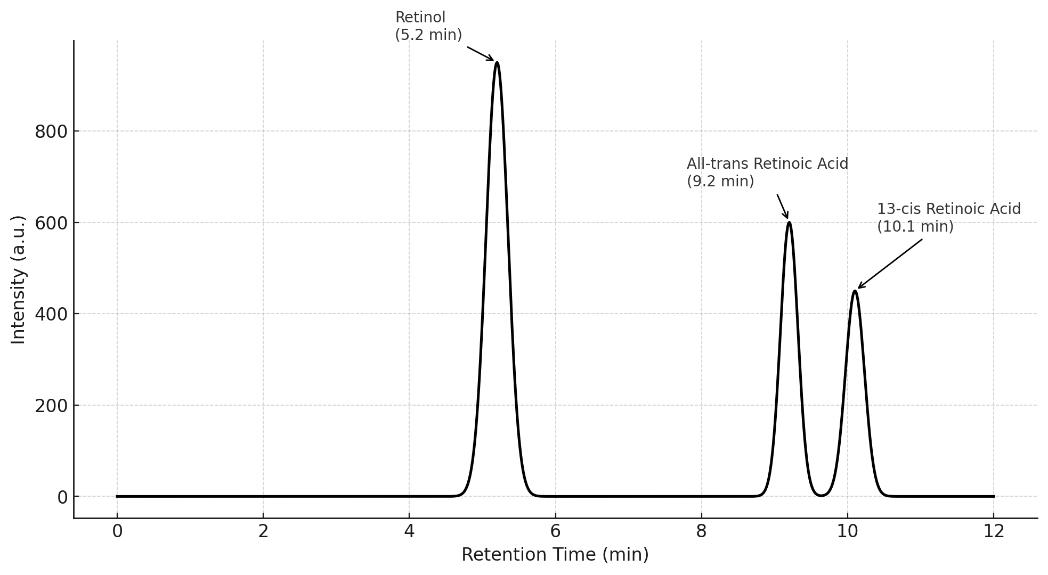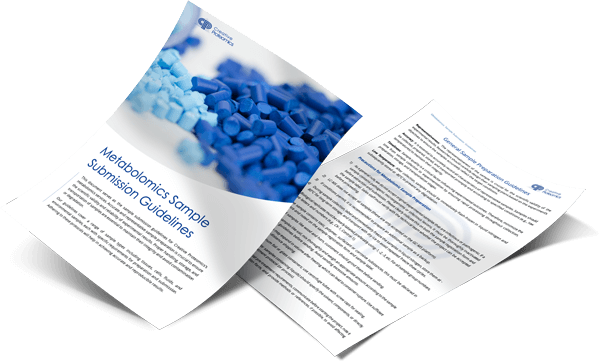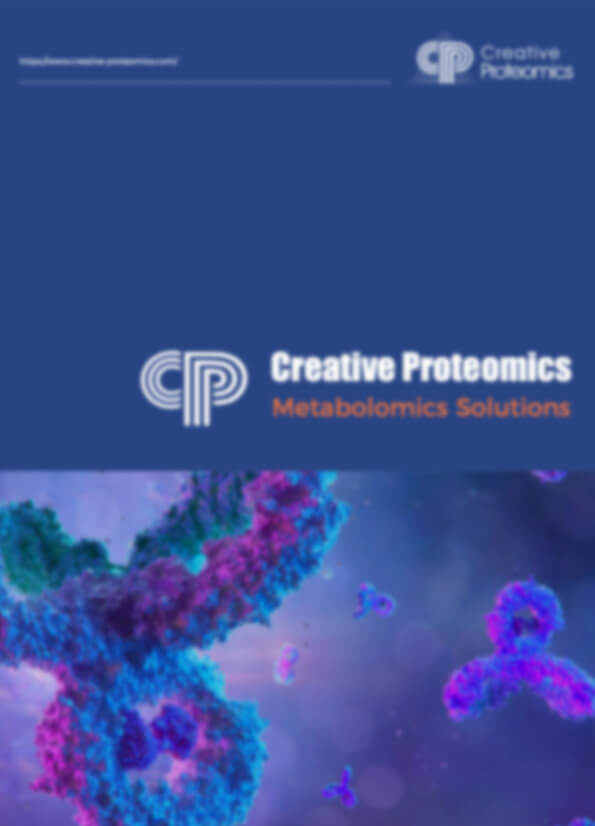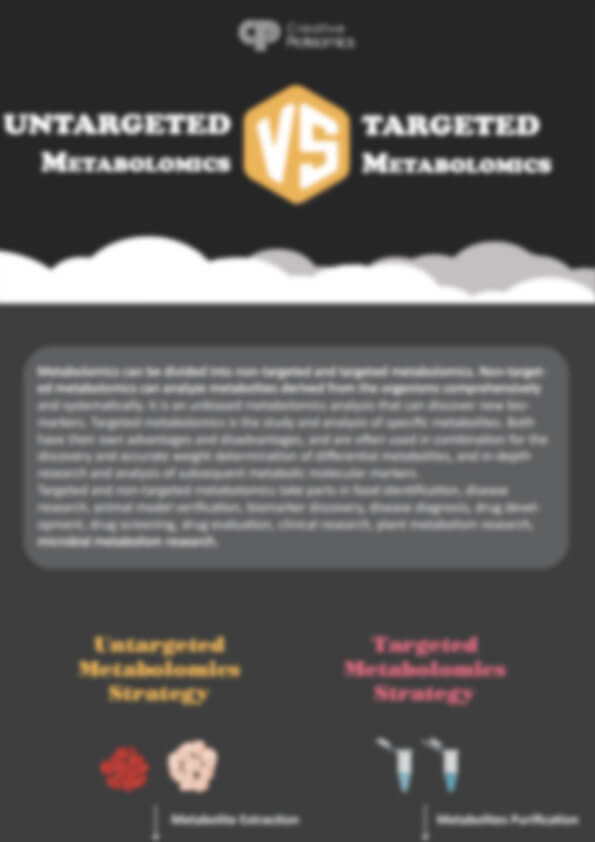Vitamin A Analysis Service
Vitamin A's complexity demands precision, sensitivity, and comprehensive coverage. Creative Proteomics delivers trusted data to optimize product development and ensure compliance.
What We Offer:
- Ultra-sensitive detection down to 0.1 ng/mL
- Comprehensive analysis of over 15 Vitamin A compounds
- Matrix-specific protocols for serum, food, cosmetics, and more
- Rapid, reproducible, and validated quantitative methods
How We Solve Your Challenges:
- Eliminate uncertainty with robust isomer separation
- Ensure product stability with degradation profiling
- Support regulatory and nutritional claims with precise quantification
- Optimize formulations through detailed metabolite analysis
Submit Your Request Now
×- What We Provide
- Advantages
- Technology Platform
- Sample Requirement
- Demo
- FAQ
What is Vitamin A?
Vitamin A refers to a group of fat-soluble retinoids—including retinol, retinal, retinyl esters, and provitamin A carotenoids such as β-carotene—essential for vision, immune function, cellular communication, and skin health. Given its lipophilic nature and diverse metabolic forms, Vitamin A requires accurate, sensitive, and robust analytical approaches to quantify and characterize its presence in biological matrices, food products, supplements, and pharmaceutical formulations.
At Creative Proteomics, our vitamin A analysis service is engineered to support researchers, product developers, and quality control teams with high-precision data that inform critical decisions across R&D and manufacturing pipelines.
Why Analyze Vitamin A?
The accurate quantification and profiling of Vitamin A is critical for several scientific and industrial applications:
- Nutritional Quality Assessment: Ensuring compliance with declared values in functional foods and fortified beverages.
- Pharmaceutical Product Development: Supporting formulation, stability, and dosage design of Vitamin A-based compounds.
- Biological Research: Studying retinoid signaling, metabolic conversions, or dietary uptake efficiency.
- Cosmetic Product Validation: Quantifying retinoids in anti-aging and dermal formulations.
Our Service Portfolio: Creative Proteomics's Vitamin A Analysis
- Quantitative Determination of Retinol and Retinyl Esters: Accurate measurement of preformed Vitamin A compounds in biological samples, supplements, and fortified foods.
- Provitamin A Carotenoid Profiling: Identification and quantification of β-carotene, α-carotene, and cryptoxanthin as essential precursors to active Vitamin A.
- Isomer Separation and Analysis: Distinguishing and quantifying geometric isomers of retinoids, including all-trans and 13-cis retinoic acid.
- Vitamin A Stability and Degradation Testing: Monitoring the stability of Vitamin A in formulations and detecting degradation products under various storage or processing conditions.
- Extraction Efficiency and Recovery Studies: Customized protocols to optimize sample preparation and validate extraction methods for maximum analyte recovery.
- Matrix-Specific Method Development: Adaptation of analytical techniques for complex matrices such as serum, plasma, tissues, oils, and cosmetic formulations.
List of Detected Vitamin A and Related Metabolites
| Analyte Name | CAS Number | Category | Detection Range (ng/mL) | LOD (Limit of Detection) |
|---|---|---|---|---|
| Retinol | 68-26-8 | Preformed Vitamin A | 0.5 – 1,000 | 0.1 ng/mL |
| Retinyl Palmitate | 79-81-2 | Retinyl Ester | 1 – 5,000 | 0.5 ng/mL |
| Retinyl Acetate | 127-47-9 | Retinyl Ester | 1 – 5,000 | 0.5 ng/mL |
| Retinaldehyde (Retinal) | 72-93-5 | Aldehyde Form | 1 – 2,000 | 0.5 ng/mL |
| All-trans Retinoic Acid | 302-79-4 | Active Retinoid | 1 – 1,000 | 0.2 ng/mL |
| 13-cis Retinoic Acid | 4759-48-2 | Isomeric Retinoid | 1 – 1,000 | 0.2 ng/mL |
| 9-cis Retinoic Acid | 514-78-3 | Isomeric Retinoid | 1 – 1,000 | 0.2 ng/mL |
| β-Carotene | 7235-40-7 | Provitamin A | 10 – 10,000 | 1 ng/mL |
| α-Carotene | 7488-99-5 | Provitamin A | 10 – 10,000 | 1 ng/mL |
| γ-Carotene | 7498-55-3 | Provitamin A Variant | 10 – 10,000 | 1 ng/mL |
| Lycopene | 502-65-8 | Carotenoid | 10 – 10,000 | 1 ng/mL |
| Cryptoxanthin | 472-70-8 | Provitamin A | 5 – 5,000 | 1 ng/mL |
| Retinyl Propionate | 5808-35-7 | Retinyl Ester | 1 – 5,000 | 0.5 ng/mL |
| Retinyl Stearate | 6106-24-7 | Retinyl Ester | 1 – 5,000 | 0.5 ng/mL |
| 11-cis Retinal | 17414-05-2 | Retinoid Intermediate | 1 – 1,000 | 0.2 ng/mL |
Distinct Advantages of Our Vitamin A Analysis Services
- Ultra-Low Detection Limits: Sensitive quantification down to 0.1 ng/mL, enabling detection of trace Vitamin A compounds.
- High Precision: Intra- and inter-assay CVs below 5%, ensuring consistent and reliable results.
- Broad Dynamic Range: Quantification from 0.1 ng/mL to 10,000 ng/mL, suitable for diverse sample types.
- Extensive Analyte Coverage: Simultaneous analysis of over 15 Vitamin A-related compounds, including isomers and carotenoids.
- Versatile Matrix Support: Validated for serum, plasma, tissue, oils, foods, and cosmetics.
- High Recovery Rates: Extraction efficiencies consistently exceeding 90% for accurate quantification.
Workflow for Vitamin A Analysis Service
1. Sample Submission & Consultation
Customers submit samples along with relevant background information. Our experts provide tailored consultation to determine optimal analysis strategies based on sample type and research goals.
2. Sample Preparation
Samples undergo carefully controlled preparation protocols to prevent Vitamin A degradation, including extraction under low light and antioxidant protection. Matrix-specific procedures (e.g., liquid-liquid extraction, solid-phase extraction) are applied.
3. Chromatographic Separation
Prepared extracts are injected into high-resolution LC systems equipped with C18 reverse-phase columns to achieve effective separation of Vitamin A isomers and related compounds.
4. Detection & Quantification
Tandem mass spectrometry (LC-MS/MS) with Multiple Reaction Monitoring (MRM) mode provides sensitive and selective quantification, with limits of detection down to 0.1 ng/mL.
5. Data Processing & Quality Control
Raw data is processed using validated software tools. Internal standards and matrix-matched calibration curves ensure accuracy. Quality control samples verify precision and recovery.
6. Comprehensive Reporting
Detailed reports including concentration values, isomer distribution, method parameters, and quality control metrics are generated. Customized data presentation formats are available upon request.
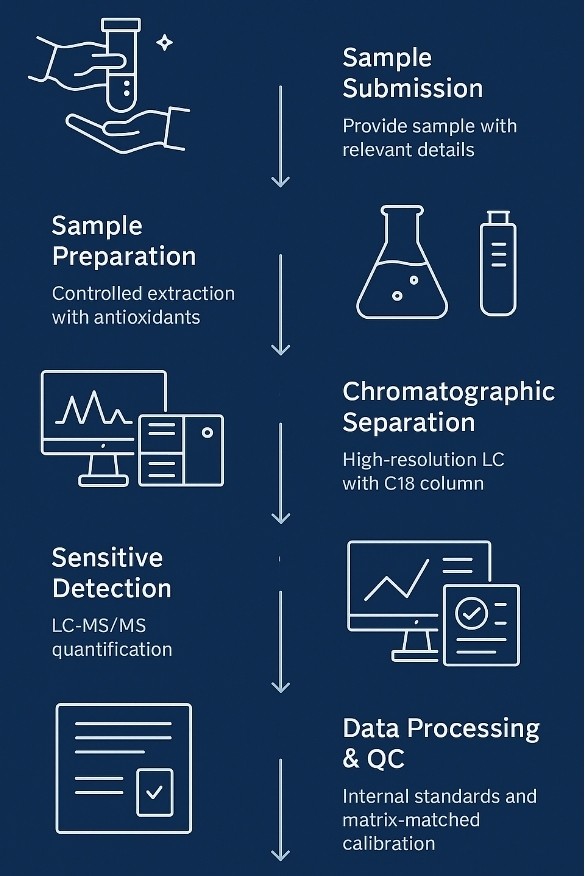
Technology Platform for Vitamin A Analysis Service
LC-MS/MS (Liquid Chromatography–Tandem Mass Spectrometry)
- System: Agilent 6495C Triple Quadrupole
- Column: C18 reverse-phase column (150 mm × 2.1 mm, 1.7 μm particle size)
- Mobile Phase: Gradient elution using methanol:water with 0.1% formic acid
- Detection Mode: Multiple Reaction Monitoring (MRM)
- LOD: As low as 0.1 ng/mL for retinoids
HPLC-DAD (High-Performance Liquid Chromatography with Diode Array Detection)
- System: Agilent 1290 Infinity II
- Wavelengths Monitored: 325 nm (retinol), 450 nm (carotenoids)
- Precision: ≤2% RSD for retention time, ≤5% for area response
UPLC with Photodiode Array (PDA) Detection
- System: Waters ACQUITY UPLC
- Advantages: High throughput and short run times (under 10 minutes per sample)
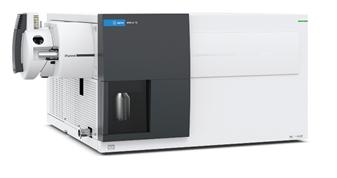 Agilent 6495C Triple Quadrupole (Figure from Agilent)
Agilent 6495C Triple Quadrupole (Figure from Agilent)
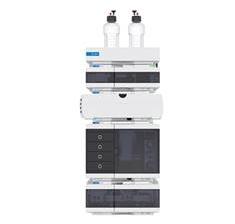 Agilent 1260 Infinity II HPLC (Fig from Agilent)
Agilent 1260 Infinity II HPLC (Fig from Agilent)
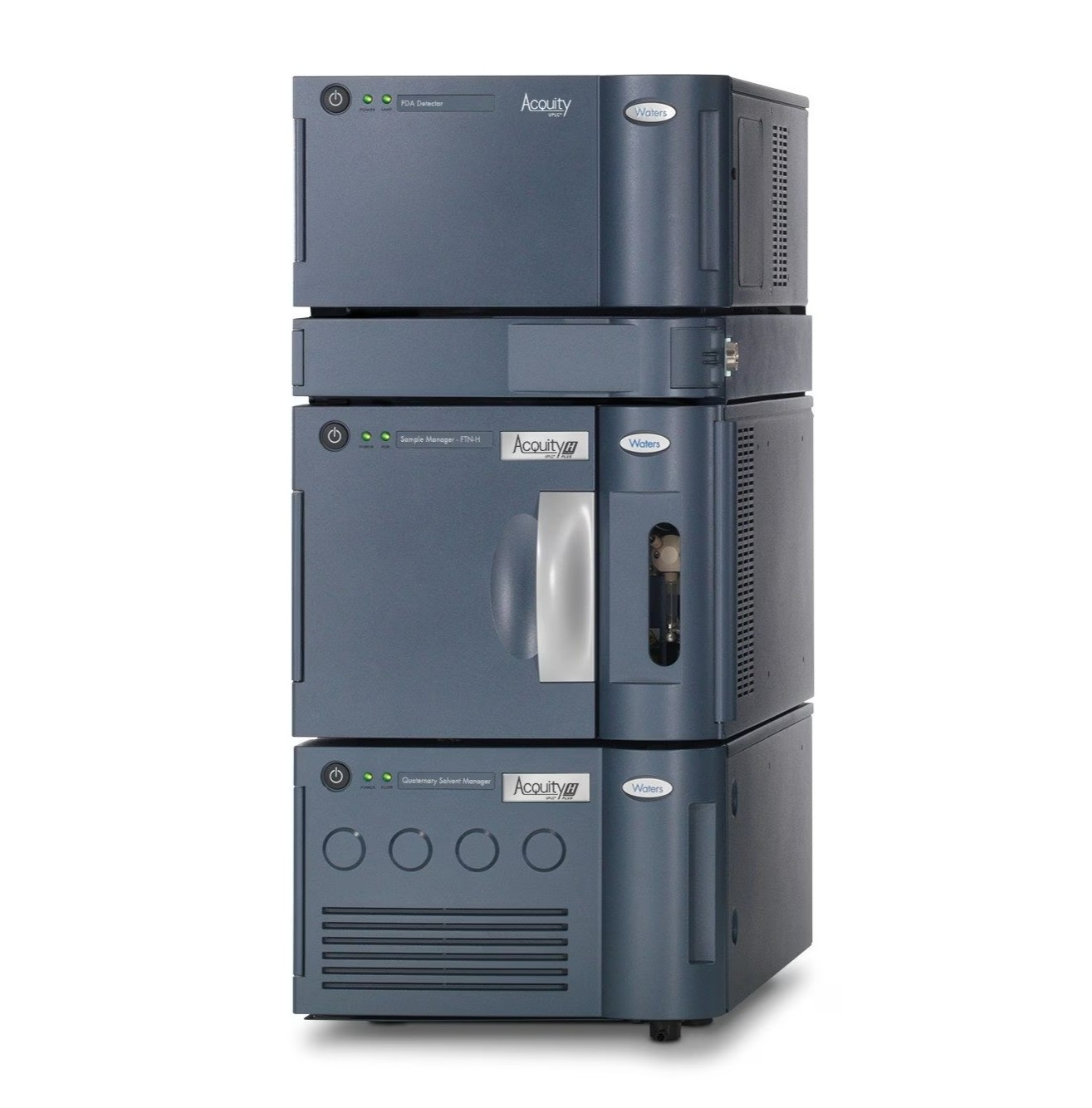 Waters ACQUITY UPLC System (Figure from Waters)
Waters ACQUITY UPLC System (Figure from Waters)
Sample Requirements for Vitamin A Analysis Service
| Sample Type | Recommended Volume/Amount | Sample Container | Storage & Shipping Conditions | Special Notes |
|---|---|---|---|---|
| Serum / Plasma | 0.5 – 1 mL | EDTA or heparin tube | Store at -80°C, ship on dry ice | Avoid repeated freeze-thaw cycles |
| Tissue (e.g., liver) | 100 – 200 mg | Cryovials | Store at -80°C, ship on dry ice | Homogenize prior to analysis if possible |
| Food Samples | 5 – 10 g | Clean, airtight container | Refrigerate or freeze depending on sample | Minimize exposure to light and heat |
| Oil & Fatty Matrices | 1 – 5 g | Amber glass vial | Store refrigerated or frozen | Avoid oxidation by minimizing air exposure |
| Dietary Supplements | 1 – 2 g (powder/capsule) | Original packaging or amber vial | Room temperature unless otherwise specified | Provide batch information if available |
| Cosmetic Formulations | 1 – 2 g | Amber glass or plastic container | Store refrigerated, protect from light | Homogenize before submission |
Demo Results
FAQ of Vitamin A Analysis Service
Can you detect both natural and synthetic forms of Vitamin A?
Yes, our methods distinguish and quantify natural retinoids and commonly used synthetic Vitamin A esters, enabling comprehensive analysis.
Are isomeric forms of Vitamin A analyzed separately?
Absolutely. Our LC-MS/MS techniques separate and quantify key isomers such as all-trans, 13-cis, and 9-cis retinoic acid, providing detailed molecular profiles.
How do you address the photo- and thermo-sensitivity of Vitamin A during sample preparation and analysis?
Samples are processed under amber light or in darkness to prevent photodegradation. Temperature-controlled steps and antioxidants (e.g., BHT) are employed during extraction to minimize oxidative losses.
What internal standards are used to ensure quantitative accuracy in Vitamin A LC-MS/MS assays?
Stable isotope-labeled retinoids such as retinol-d6 and retinyl acetate-d6 are incorporated as internal standards to compensate for matrix effects and sample loss during preparation.
How is chromatographic resolution optimized for separating Vitamin A isomers?
A high-efficiency C18 reverse-phase column with sub-2 µm particle size, combined with a finely tuned gradient elution program, achieves baseline separation of geometric isomers including all-trans, 13-cis, and 9-cis retinoic acid.
What measures are taken to control matrix suppression or enhancement effects in complex biological samples?
Matrix-matched calibration curves and post-column infusion experiments are used to assess and correct ion suppression/enhancement. Sample cleanup via solid-phase extraction (SPE) is routinely performed to reduce interfering substances.
Can you quantify both free retinoids and esterified Vitamin A forms within the same analytical run?
Yes, our extraction protocols allow simultaneous recovery of both free and esterified retinoids, enabling comprehensive profiling without separate assays.
What is the typical precision and accuracy achieved in Vitamin A quantification?
Inter- and intra-day precision (RSD) is consistently below 5%, with accuracy ranging between 95–105% based on quality control standards.
How is method validation conducted for diverse sample matrices?
Validation includes assessment of linearity, limit of detection (LOD), limit of quantification (LOQ), recovery, precision, and matrix effects across multiple representative matrices such as serum, tissue, and oils.
Learn about other Q&A about proteomics technology.
Publications
Here are some of the metabolomics-related papers published by our clients:

- Comparative metabolite profiling of salt sensitive Oryza sativa and the halophytic wild rice Oryza coarctata under salt stress. 2024. https://doi.org/10.1002/pei3.10155
- The Brain Metabolome Is Modified by Obesity in a Sex-Dependent Manner. 2024. https://doi.org/10.3390/ijms25063475
- Regulation of host metabolism and defense strategies to survive neonatal infection. 2024. https://doi.org/10.1016/j.bbadis.2024.167482
- White matter lipid alterations during aging in the rhesus monkey brain. 2024. https://doi.org/10.1007/s11357-024-01353-3
- Multiomics of a rice population identifies genes and genomic regions that bestow low glycemic index and high protein content. 2024. https://doi.org/10.1073/pnas.2410598121
